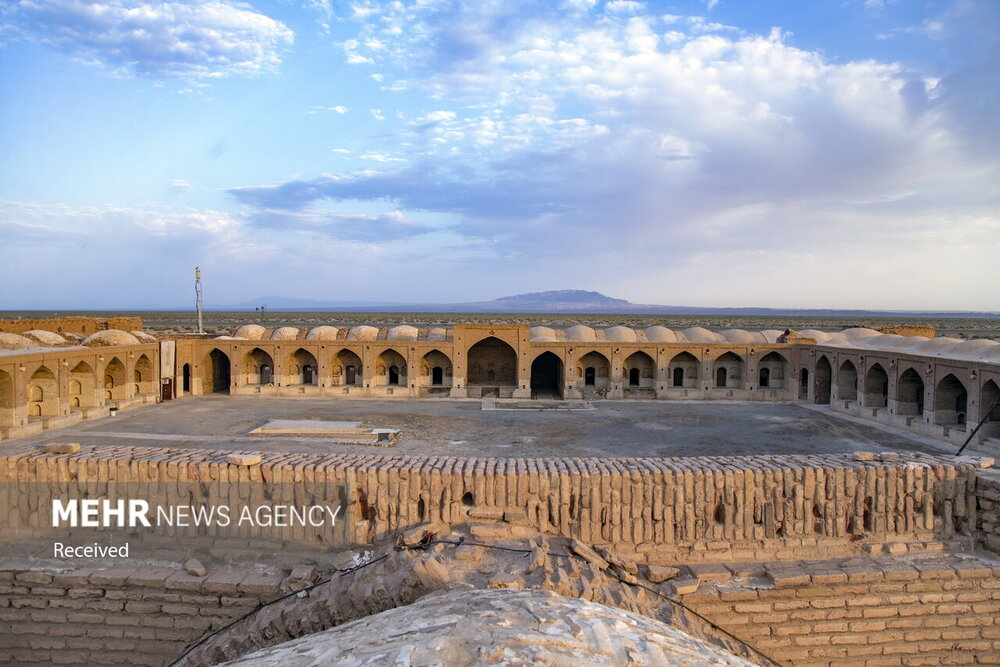Deir-e Gachin Caravanserai in Qom joins shortlist for collective UNESCO tag

TEHRAN – The millennia-old Deir-e Gachin Caravanserai has joined a shortlist of traditional inns that Iran pursues its possible inscription as a UNESCO World Heritage.
Located in the central province of Qom, the caravanserai has received cultural heritage experts’ preliminary approval to join the shortlist, the provincial tourism chief has said.
An all-inclusive dossier for Deir-e Gachin Caravanserai has been prepared and it is expected to gain UNESCO status due to its antiquity, special architectural style, and various features, Alireza Arjmandi explained on Tuesday.
Listing as a UNESCO World Heritage would lead to better and more protection for the caravanserai, which is estimated to date back to almost 1750 years ago and the Sassanid era (224-651 CE), the official added.
During that time, this building served as a fortification on the Silk Road, but during the Islamic period, it became a caravanserai, a place for travelers to rest, he noted.
The historical inn was inscribed on the national heritage list in 2003.
Deir-e Gachin Caravanserai is one of the greatest caravanserais of Iran, which is located in the center of Kavir National Park, 80 kilometers from Qom.
Considered the “Mother of Iranian Caravanserais” due to its unique features and antiquity, the caravanserai was built during the Sassanid era (224 CE–651), which means it is more than 1750 years old.
The caravanserai, which was once of the most prosperous roadside inns across the country, was renovated and restored during the Seljuk and Safavid eras, and new sections were added to it during the Qajar period.
The name Deir-e Gachin (literally meaning “cloister of plaster”) comes from the fact that gigantic loads of plaster were used for its construction.
Iran’s second holiest city after Mashhad, Qom is home to the holy shrine of Hazrat-e Masumeh (SA), several major seminaries, madrasas as well as many tourist resorts both cultural and natural.
Qom, which its antiquity goes back to the Sassanid era (224 CE–651), has many must-see destinations such as historical mosques, mansions, and natural sceneries scattered across the city as well as towns and villages nearby.
Possible UNESCO tag for Iranian caravanserais
Iran has put forward a selection of 56 caravansaries as a candidate for a collective inclusion in UNESCO’S cultural heritage list.
Last year, the tourism ministry announced that Iran is developing a dossier for a selection of its historical caravanserais for a possible inscription on the UNESCO World Heritage list. In this regard, cultural heritage experts are assessing such monuments that are scattered across the country to make a shortlist in terms of their architecture, as well as historical and cultural values.
Caravansary (also Caravanserai or Caravansaray) is a building that served as the inn of the Orient, providing accommodation for commercial, pilgrim, postal, and especially official travelers.
According to Encyclopedia Iranica, from the number of surviving caravansaries and their sizes, it is clear that in Safavid and Qajar times there was a state architectural department that was specifically concerned with the construction of caravansaries and stations on the overland routes. Furthermore, in the cities, several caravansaries were erected as lodging houses, depots, and commercial offices in the vicinity of the bazaars.
A typical caravansary consists of a square or rectangular plan centered around a courtyard with only one entrance and arrangements for defense if necessary. Whether fortified or not, it at least provided security against beasts of prey and attacks by brigands.
The earliest caravanserais in Iran were built during the Achaemenid era (550 -330 BC). Centuries later, when Shah Abbas I assumed power from 1588 – to 1629, he ordered the construction of a network of caravanserais across the country.
For many travelers, staying in or even visiting a centuries-old caravanserai, can be a wide experience; they have an opportunity to feel the past, a time travel back into a forgotten age.
Such roadside inns were once constructed along ancient caravan routes in the Muslim world to shelter people, their goods, and animals. The former Silk Roads may be the most famous example dotted by caravanserais.
Cozy chambers that are meticulously laid out around a vast courtyard may easily evoke spirits of the past. It’s not hard to fancy the hustle and bustle of merchants bargaining on prices, recounting their arduous journeys to one another while their camels chewing hay! You can also conceive the idea of local architectural style and material in its heyday.
It is not hard to fancy the hustle and bustle of merchants bargaining on prices, recounting their arduous journeys to one another while their camels chewing hay!
Passing major roads in the country, one may see crumbling caravanserais many of which were abandoned for ages. In the Information Age, such guest houses have largely lost their actual usage.
However, a couple of years ago, the Iran tourism ministry introduced a scheme to keep them alive and profitable; tens of caravanserais are ceded to the private investors for better maintenance. Now, some are exclusively renovated and repurposed into boutique hotels and tourist lodgings.
They often had massive portals supported by elevated load-bearing walls. Guest rooms were constructed around the courtyard and stables behind them with doors in the corners of the yard.
ABU/MG
Leave a Comment